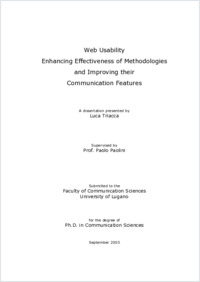Web usability : enhancing effectiveness of methodologies and improving their communication features
- Triacca, Luca
- Paolini, Paolo (Degree supervisor)
-
28.11.2005
140 p
Thèse de doctorat: Università della Svizzera italiana, 2005 (jury note: magna cum laude)
Web usability
Web design
Heuristic eveluation
User testing
Usability methods
Reusability of methods
MiLE+ method
English
The quality of web sites (or more in general interactive applications) may be improved taking into account the activity of usability evaluation, in which the quality for the endusers is defined and established. One of the most serious problems related to usability field is that usability evaluation methods often were not defined to be effectively reused by the people who did not invent them. The consequence of this lack of reusability is that it is very difficult to promote and disseminate this fundamental activity and consequently it is not enough considered within projects and relative budgets. The thesis presents a systematic usability method, called MiLE+, which has been developed taking into account the concept of reusability. MiLE+ is the evolution of MiLE (Milano-Lugano Evaluation method) and it tries to improve its forerunner at conceptual level and, as far as reusability is concern, it offers several tools easy-and-ready to use by inspectors. From the conceptual point of view, one of the most important and innovative contribution is referred to the introduction of the separation between application dependent and independent analysis. This approach allows a usability evaluation more focused on taking into account the nature of the problem and as a consequence it suggests more precise solutions. This distinction influences the three evaluation activities composing the MiLE+ framework: technical inspection, user-experience inspection and scenario-based user testing. The technical inspection is devoted to discover usability problems which are not related to specific application’s goals and users, meanwhile the user-experience inspection and the scenario-based user testing are used for identify issues that are strictly connected to the nature of the application under evaluation. All the MiLE+ activities employ several tools developed taking into account the conceptual framework behind the method. These tools allow a deep analysis of the web site, in particular: − heuristics for the technical inspection (called technical heuristics), that allow the discovery of problems related to application-independent aspects; − heuristics for the user-experience inspection and for the scenario-based user testing called user experience indicators – UEIs), that allow finding the problems related to application-dependent aspects; − scenarios, that allows to evaluate the application taking into account the main user profiles and their goals; − usability evaluation kits (U-KITs), that are the toolset which the inspector has to set up before the evaluation. Another very important feature of the method is its cost-effectiveness. Indeed, in this work it has been highlighted how the MiLE+ activities can be employed considering constraints such as time and resources at disposal. The reusability of a method is also related to the learning activities that help to communicate and teaching the methodology. So, this work presents in a very detailed manner all the learning activities (courses and modules) and support material (inspector manual) that have been conceived to simplify the understanding and the method’s utilization. To assess and validate the method we present an experiment which, at least in part, proposes an innovative approach to verify the reusability of a usability evaluation method. This approach is based on the concept of agreement on findings among inspectors, which refers to the reliability of the problems’ detection obtained by the inspectors themselves. In other words, this approach allows to empirically measuring the ability of the inspectors to produce results that should be comparable and similar.
- Language
-
- English
- Classification
- Computer science and technology
- License
-
License undefined
- Identifiers
-
- RERO DOC 6304
- URN urn:nbn:ch:rero-006-108399
- ARK ark:/12658/srd1318237
- Persistent URL
- https://n2t.net/ark:/12658/srd1318237
Statistics
Document views: 395
File downloads:
- Texte intégral: 246
